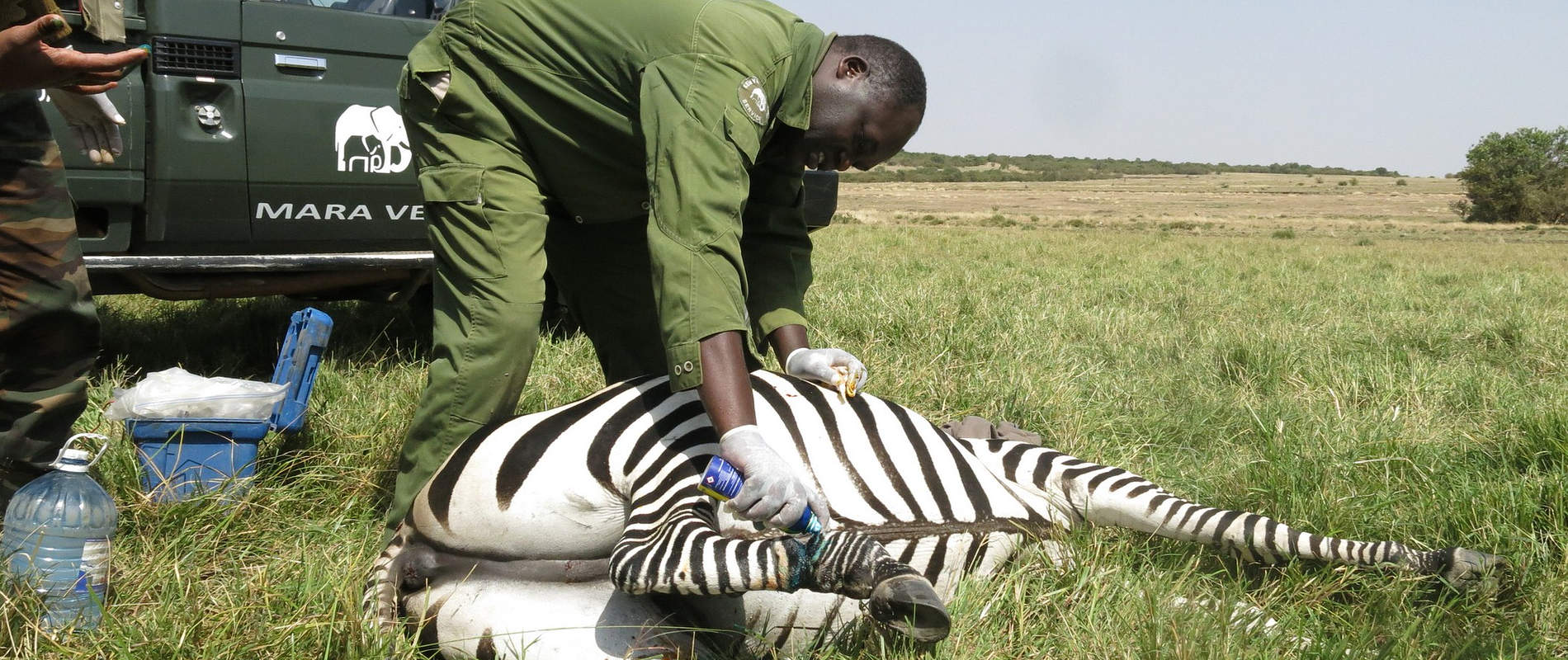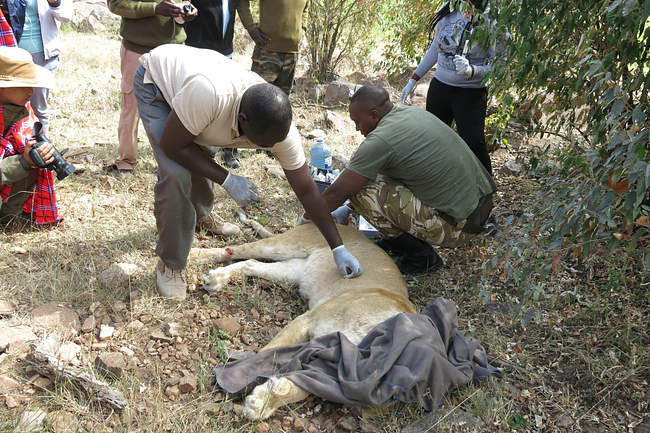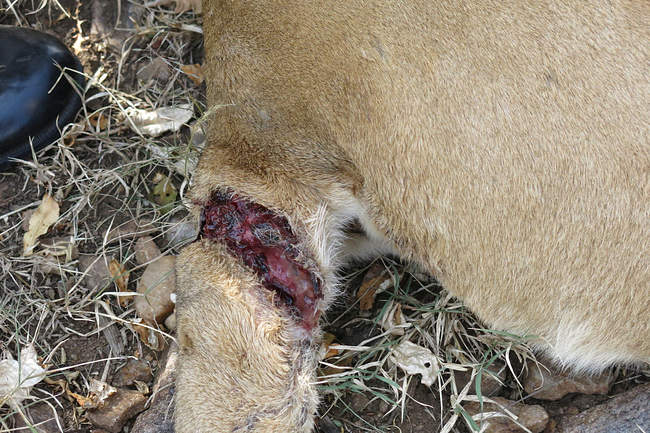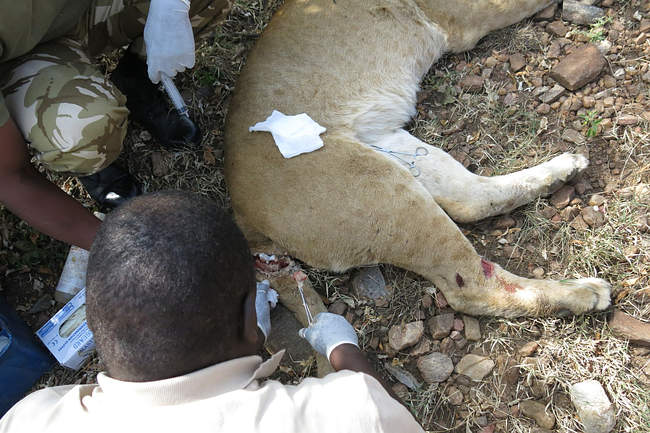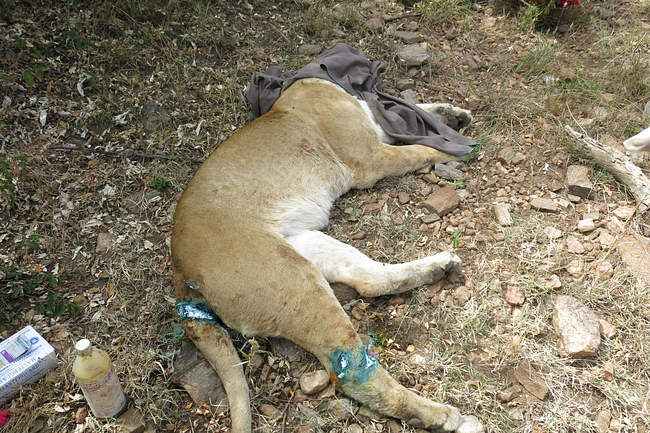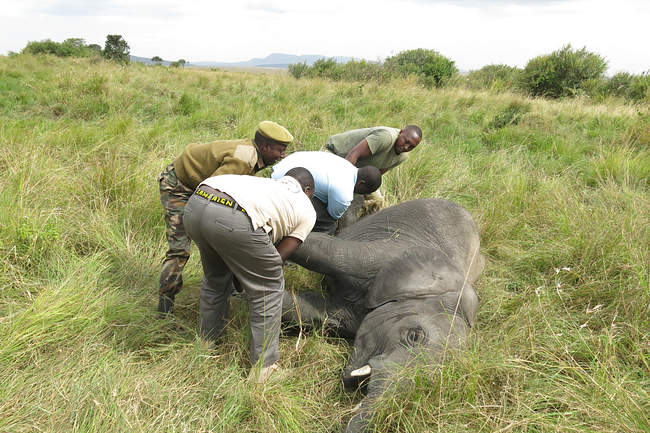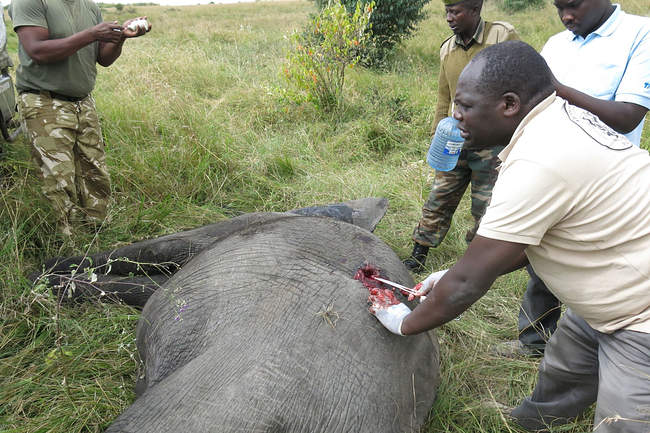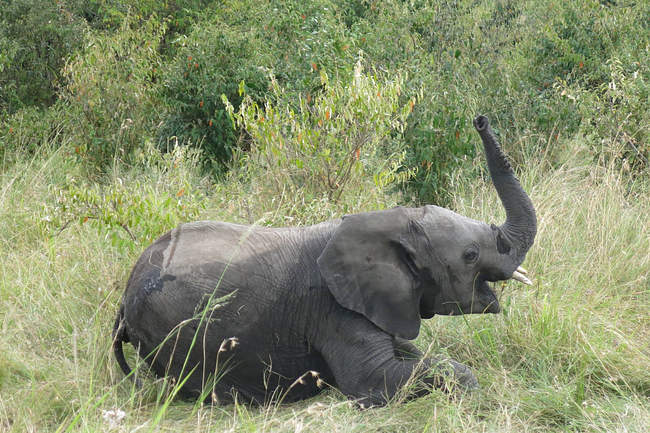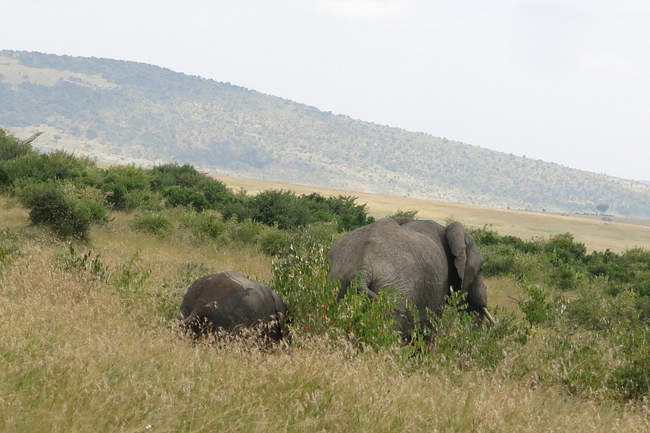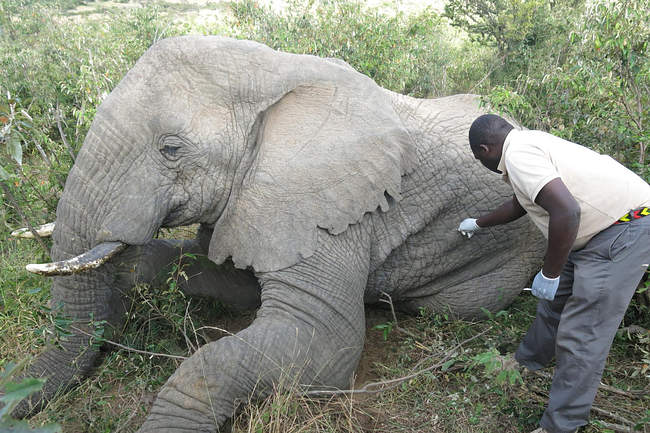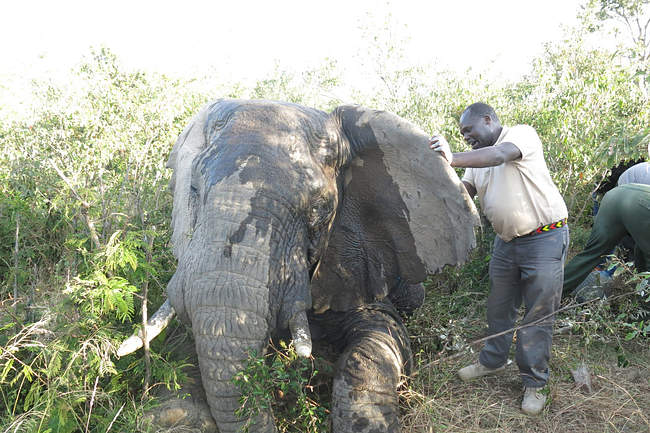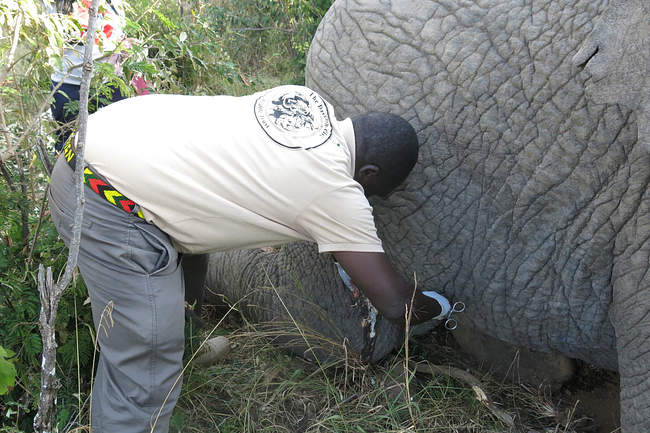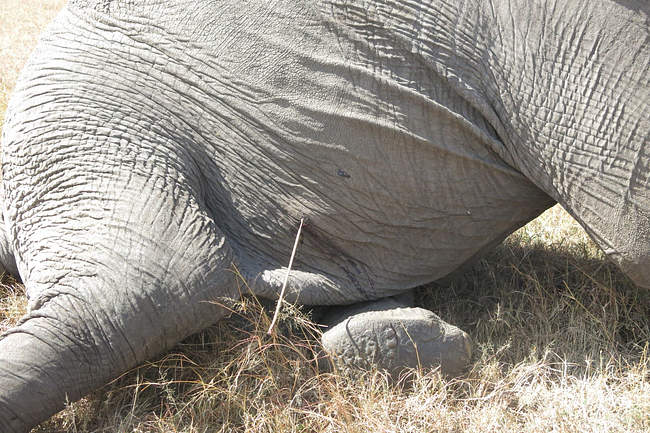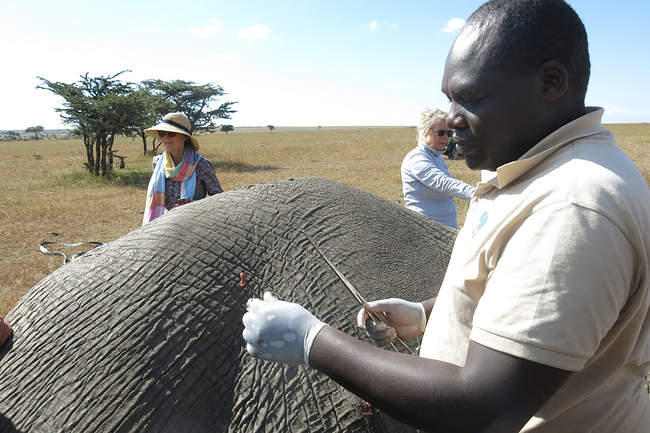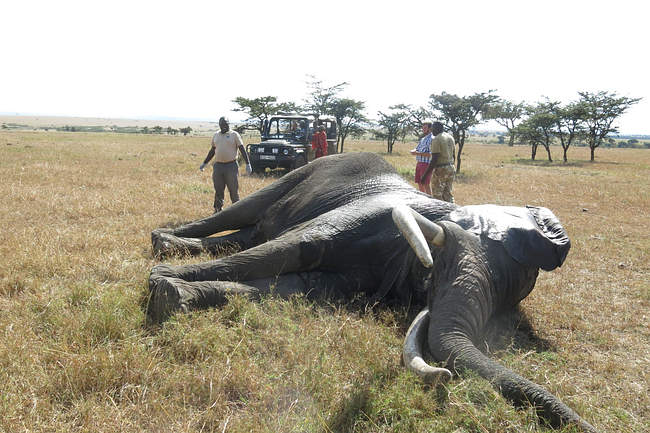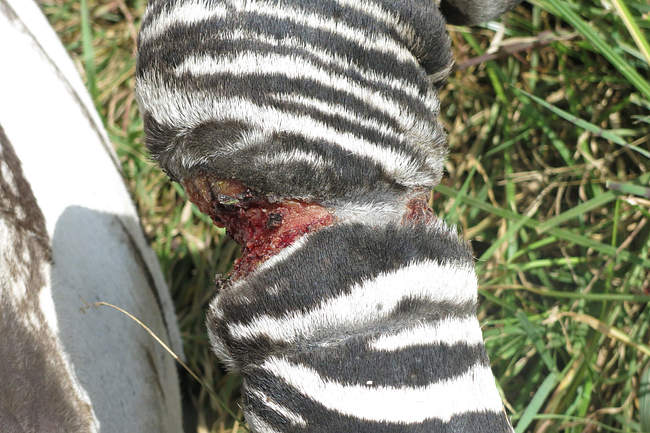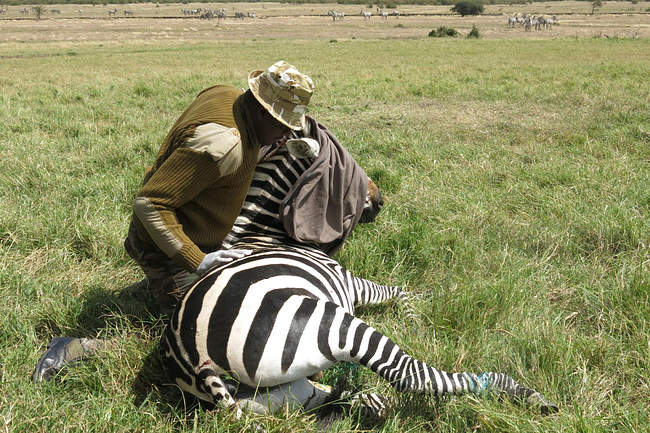The ecosystem remained dry throughout the month with plenty of food for grazers and browsers owing to rains registered early to mid-year. Most water pans are still full. Few cases were reported and attended to with most of the injuries as a result of human activity. All were considered out of danger and are expected to make full recovery.
CASE#1: INJURED LIONESS
Date: 10th July 2018
Species: African lion
Sex: Female
Age: Adult
Location: Olkinyei Conservancy
History: This lioness with two cubs was seen with injuries suspected to have been inflicted by other lions following territorial fights and reported to the unit by Olkinyei conservancy management. She was found with her cubs close to a small river with relatively fresh bite injuries at the base of her tail and anterior aspect of her right hock. She appeared calm lying under a shade.

Immobilization, examination and treatment: She was chemically restrained by use of a combination of 4.8mgs Medetomidine Hydrochloride and 200mgs Ketamine delivered through a 3ml daninject dart from a vehicle. She immediately crossed the drying river and soon got overwhelmed by the anaesthetics after settling in the shade. It took eight minutes for her to get fully anaesthetized.
Upon examination, it was found that both injuries were occasioned by territorial fights with other lions. The young cubs gave us space to treat their mother by moving a short distance whilst still keeping watch. The wounds were debrided using Hydrogen Peroxide and gauze swabs, and then rinsed with clean water. Tincture of Iodine was used for disinfection before Oxytetracycline wound spray being applied. Other treatments administered include 3000mgs Amoxicillin antibiotics and 50mgs Ivermectin Parasiticide to control internal and external parasites.
Reversal and prognosis: Reversal was done one hour after immobilization using 15mgs atepamezole hydrochloride intramuscularly through the shoulder muscle. She woke up after eight minutes to join her cubs. Prognosis for full recovery is good.
CASE#2 INJURED ELEPHANT CALF
Date: 10th July 2018
Species: African elephant
Age: Approximately 3 years
Sex: Male
Location: Masai Mara National Reserve (Keekorok area)
History: This baby elephant with an injury on the left flank was seen by tourists visiting Masai Mara on their game drives. This then came to the attention of the veterinary unit with the team setting out to search for the calf. He was located mud bathing with his mother with no other elephant in sight. He had a relatively fresh wound on his left flank with part of the skin tissue hanging and appeared to be in pain.

Immobilization, examination and treatment: Immobilization was achieved by use of 3mg etorphine hydrochloride delivered through a 1.5ml daninject dart. Darting was done from the vehicle with the mother being driven gently away from the calf as drugs took effect. She initially resisted but finally gave in and moved a short distance to watch over as the calf was being treated.
This calf assumed left lateral recumbency and was turned over for better examination which revealed a 2-3day old spear wound which partly caused damage to his abdominal muscles. Hanging skin was trimmed and the wound was debrided with Hydrogen Peroxide. It was then rinsed with clean water before being disinfected with Tincture of Iodine. Green clay was then packed to hasten healing. Other treatments instituted include parenteral administration of 4500mgs Amoxicillin antibiotics and 1000mgs Flunixin Meglumine anti-inflammatories.
Reversal and prognosis: Reversal was achieved by intravenous administration of 12mgs diprenorphine hydrochloride through a prominent ear vein. He rose up in three minutes to re-unite with his mother. Prognosis for full recovery is good.
CASE#3 ELEPHANT COLLARING
Date: 12th July 2018
Species: African elephant
Age: Adult
Sex: Female
Location: Mau forest
History: Mara Elephant Project partnering with KWS, Narok County Government and other stakeholders agreed to deploy some collars to a population of elephants in the Mau Forest to track them for security purposes and to learn wildlife (elephant) land use within the forests. This adult female was found with two young calves, one sub adult and an adult female assumed to be members of a family.
Immobilization and collaring: After herding them to the edge of the forest, the older of the two females assumed to be the matriarch was darted from a helicopter with 15mgs Etorphine Hydrochloride in a 1.5ml daninject dart. It took ten minutes for her to be fully immobilised with the other family members moving away as soon as she went down. She was confirmed to be in perfect body condition and ideal for collaring. A satellite/GSM collar was fastened around her neck.

Reversal and prognosis: Reversal was achieved with 42mgs Diprenorphine Hydrochloride administered through a prominent ear vein. She woke up after 4 minutes to join the other family members.
CASE#4 INJURED ELEPHANT
Date: 13th July 2018
Species: African elephant
Sex: Male
Age: Adult
Location: Olarro Conservancy
History: This adult bull in a big herd of elephants was seen with suppurating wounds on his left flank and anterior aspect of his right knee by Olarro Conservancy rangers. They sought our help for intervention. He was found in a mixed herd of approximately fifty elephants. Save for the injuries, his body condition was good.

Immobilization, examination and treatment: Immobilization was achieved by use of 16mgs Etorphine Hydrochloride delivered through a 3ml daninject dart. Darting was done from a vehicle. It took ten minutes for the drugs to take full effect with this elephant going down in a small thicket. Working space was limited, and having assumed sternal recumbency, the team decided to handle him in this position but quickly with close monitoring. Both wounds were examined and probed for foreign bodies, which was negative.
All necrotic tissues were debrided with the help of gauze swabs and Hydrogen Peroxide before being rinsed with clean water and disinfected with Tincture of Iodine. Green clay was packed on the bigger left flank wound. These were approximately two week old wounds considered to have been caused by spearing. Further treatments involved intramuscular administration of 30000mgs Amoxicillin antibiotic and 5000mgs Flunixin Meglumine anti-inflammatories.
Reversal and prognosis: Reversal was achieved by administration of 42mgs Diprenorphine Hydrochloride intravenously through a prominent ear vein. He rose up in four minutes to join the rest of the herd. Prognosis for full recovery is good.
Our Mobile Vet Units are in the field every day saving wild lives
CASE#5 INJURED ELEPHANT BULL
Date: 16th July 2018
Species: African elephant
Sex: Male
Age: Adult
Location: Mara North Conservancy
History: This collared old bull christened ‘Hugo’ approaching 50 years was seen with an intact arrow on his right abdomen by Mara North Rangers and a group of visiting tourists. They called the Mobile Veterinary Unit for intervention. Hugo was found alone in a relatively open plain in pain and dust bathing. The intact arrow could be seen firmly attached to the lower portion of his right abdomen.

Immobilization, examination and treatment: Restraint was achieved chemically by use of 17mgs Etorphine Hydrochloride delivered through a 3ml daninject dart. Darting was done from a vehicle. He was then gently guided to an open plain before the drugs took full effect after 12 minutes. He initially assumed sternal recumbency before being pulled to lie on his left lateral position for ease of examination and comfort.
Examination revealed a firmly attached barbed arrow on his right abdomen which appeared recently attached, not more than 24hrs old.The entire arrow with the shaft was gently worked out and resultant wound debrided with the use of Hydrogen Peroxide and gauze swab. Clean water was used for rinsing with Tincture of Iodine being applied for disinfection. Cloxacillin antibiotic ointment was then infused. Other treatments include intramuscular administration of 30000mgs Amoxicillin antibiotic and 5000mgs Flunixin Meglumine anti-inflammatories. Fortunately, this was a non-poisoned arrow.

Reversal and prognosis: Reversal was done by administration of 48mgs Diprenorphine Hydrochloride intravenously through a prominent ear vein. He woke up in four minutes and walked into a nearby small thicket. Prognosis for full recovery is good.
CASE#6 INJURED CHEETAHS
Date: 19th July 2018
Species: Cheetahs (Acinonyx jubatus)
Sex: Both Males
Age: Adults
Location: Masai Mara National Reserve (Talek area)
History: These two males, part of a famous coalition of five males were seen with injuries by the Masai Mara Reserve rangers on their normal patrols. They called the unit for assessment. It was reported that they fought with their colleagues over mating rights.

General observation and diagnosis: The two were found about hundred metres apart each lying in the shade. When agitated to move, they did so reluctantly with mild bite wounds thought to be from other cheetahs seen on their bodies. The other three members of the coalition could not be seen but were thought to have left with the female cheetah. Both cheetahs were considered out of danger and no immediate requirement for intervention was necessary. The team was advised to monitor them and report their progress. So far they are doing well.
CASE#7 SNARED ZEBRA
Date: 22nd July 2018
Species: Common zebra
Sex: Male
Age: Adult
Location: Olerai Conservancy
History: This male was seen dragging a snare on his left hind leg by Olerai Conservancy rangers prompting their manager to seek our intervention. He was seen grazing with other zebras but occasionally lifting the affected limb because of pain. When agitated to move, he did so with difficulty.

Immobilization, examination and treatment: Restraint was achieved chemically with a combination of 6mgs Etorphine Hydrochloride and 50mgs Azaperone delivered through a 1.5ml daninject dart. Darting was carried out from a vehicle with this zebra being full immobilised after 5 minutes.
Examination revealed a relatively tight plain wire snare round his right distal metatarsus. The snare was released and the resultant wound which appeared relatively fresh being cleaned with water and disinfected with Tincture of Iodine. Oxytetracycline wound spray was then applied. Additionally, he received parenteral injection of 3000mgs Amoxicillin antibiotics and 1000mgs Flunixin Meglumine anti-inflammatories.

Reversal and prognosis: Done by administration of 18mgs Diprenorphine Hydrochloride through the jugular vein. He rose up in two minutes to join the rest of the herd. He is expected to make a full recovery.
CASE#8 INJURED BUFFALO
Date: 22nd July 2018
Specie: Cape buffalo
Sex: Female
Age: 3 years
Location: Masai Mara National Reserve (Sarova area)
History: This young female was seen injured near a fence round Sarova Hotel by Sarova security personnel. They informed Masai Mara Reserve security team and at the same time the Mobile Veterinary Unit. She was found in a small thicket near an electric fence bordering Sarova Hotel unable to stand, seemingly in a lot of pain. However she died before any closer examination or intervention could be done.

She was pulled away from the fence to some distance and post-mortem examination was carried out. It was established, she had survived a predator attack which caused severe injuries to her muzzle, back and perineal area. This could have been a lion attack. The wounds were getting septic, foul smelling with maggot infestation. She died of severe sepsis and spinal damage as a result of attempted predation from large carnivores.
Acknowledgments
Report by Dr Campaign Limo. The unit would like to thank the many stakeholders who monitored and reported wildlife cases requiring intervention. Many thanks to Minara foundation through the DSWT for continued facilitation to the unit. Thanks to KWS management for their technical support and advice to the unit.
